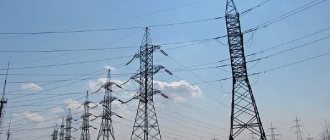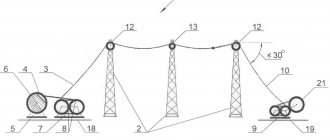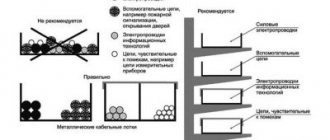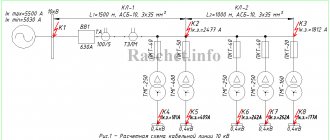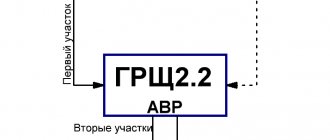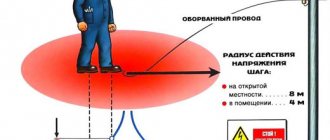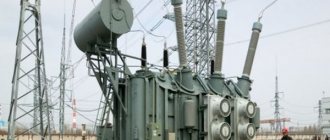Distance from power lines and magnetic radiation
At what distance should you not live near power lines:
- To avoid risks, the routes of electromagnetic fields that pass through such lines are delineated by sanitary protection zones. Their size corresponds to the voltage class and ranges from 20 to 55 meters (in Moscow these values range from 10 to 40 meters).
- The distance is calculated from the wall of the house to the wires. Within these zones, the construction of housing, summer cottages, public buildings, as well as the location of gardens and vegetable gardens is not allowed.
- These values do not take into account the magnetic field surrounding the power line. Therefore, experts recommend that to fully guarantee safety, consider the distance to be ten times the specified standards.
- For example, the distance around low voltage lines within a radius of 100 meters is a completely sufficient sanitary protection zone. The fact is that there are no official data regarding harmful emissions from power lines, so you should focus on the standards established by documents and your own well-being.
Opinions vary about how dangerous it is to live near power lines. Those who consider them dangerous cite statistics of deaths in areas where high-power power lines pass to prove that they are right. Doctors do not completely agree with this statement and refer to their own indicators and calculations.
Opinions about the harm vary
The truth, as usual, is in the middle: constantly being near the support of a 750-kilovolt line, it is quite possible to feel unwell. If the contact with the power line is not constant and the correct distance from it is maintained, the body is unlikely to react to the influence of the electromagnetic field.
When electrons pass through wires, they create an electromagnetic field around their carrier. Depending on the type of current, the radiation value is constant or variable. A continuous change in the current value from plus to minus and vice versa causes the field to change its value 2 times more often.
In the evening
Research on the effects of electromagnetic radiation on humans and wildlife began to be carried out at the end of the 70s. Based on the results of a survey of people in different countries, the WHO - World Health Organization determined the maximum permissible radiation levels in hertz per unit of time. In the Russian Federation and other countries, regulations have been developed prohibiting industrial and civil construction at close distances from power lines.
Security zone
People who spent a long time in the strong field zone were diagnosed with cancer and heart disease. Women suffered from infertility. Men were plagued by pathologies of the genitourinary system. General weakness appeared. Life expectancy was reduced.
Based on SanPiN standards, construction rules were developed and sanitary zones were created under high-voltage lines. Children's institutions located in the danger zone must be closed. It is prohibited to build residential buildings for permanent and temporary residence closer than the distance indicated to high-voltage lines in SanPiN 2971-84.
It is impossible to sell a house located in a dangerous area. Sanitary and fire safety organizations will not approve such a document. When developing individual housing construction sites, it is necessary to take into account the distance to the power lines located nearby.
Electromagnetic wave propagation diagram
How dangerous the radiation from high-voltage lines is is demonstrated by land prices. The cost of plots near power lines is low. As you move away, it rises every 50 m. You shouldn’t be tempted by the cheapness. You need to think about the health of your family.
Should I build a house near power lines?
They offer to buy a plot in a dacha cooperative; collective ownership of all plots has been established. The problem with the plot of land for sale is that to the left of it (almost above it) there is a power line running on such healthy metal pyramids of an “openwork” appearance. In general, a multi-kilovolt line. Now on the site there is a “shack” one meter by one meter. If I buy it, I will build a house. What are the restrictions on development in the vicinity of power lines? The nearest line post is approximately 100-150 meters from the property line.
This is interesting: Dynamics of Housing Rental Prices in St. Petersburg at the Beginning of 2020
That's the question. We looked at the plan for the PARTNERSHIP, a kind of huge footcloth with “squares” - land plots. Everything is there.. Both this site and the neighboring one. And all sorts of oil pumps, oil pipelines, gas lines. But there is no electricity. As one of the summer residents explained to me, he went to register his plot INDIVIDUALLY, and there he was told “20 meters - do not water the land, do not fly kites, provide passage. Don't build.."
Health hazards from power lines
Power lines emit static fields and alternating waves. However, the same radiation comes from electrical wiring and from any electrical appliances that are located in our houses and apartments. When comparing a 220 V AC outlet located one meter away from a person and a power line transmitting approximately 200 kV current located thirty meters away, and considering that the strength of the static field decreases in proportion to the square of the distance, both of these radiation sources influence approximately the same.
The calculation shows that the equivalent of an outlet located a meter away from us would be a power line transmitting a current with a voltage of 6.5 kV. In addition, it should be borne in mind that in our house there are several sockets, up to tens of meters of electrical wiring, a TV, refrigerator, computer, and other electrical appliances, whose radiation can be much stronger.
We invite you to read: At what age is pregnancy allowed in Ukraine?
At the same time, these manifestations may be associated with the need for constant composure, accuracy and attentiveness, which distinguishes this profession from other jobs in which the need for increased attention arises only periodically.
A voltage of 10 kV is considered safe for humans. It creates a background density not exceeding 10 μT - microtesla. For comparison, the Earth's magnetic field is 30–50 μT.
Standard support drawing
It differs from the radiation generated by overhead lines in that it has a constant or smoothly varying value. A current with a frequency of 50 Hz passes through the power line - this means that per second the current changes its direction 50 times, a complete oscillation occurs - an alternating current wave. The value of the emitted magnetic field also changes with this frequency.
The highest value of natural vibrations reaches 40 Hz. When constantly in the zone of magnetic waves with high values, malfunctions occur in the human body. This is possible not only when standing under power lines for a long time, but also next to household electrical appliances, especially thermal ones. The damage from the close proximity of overhead lines is commensurate with the harm to health caused by an iron, refrigerator, washing machine, or computer.
Types of supports
In the European Union, it is generally accepted that if the voltage in the power line wires is higher than 35 kV and the apartment is located closer than the standard interval of the security zone plus 20 m, then, according to the health standards of the United Europe, such proximity can cause a number of diseases of the nervous, cardiovascular and immune systems. systems
The distance from power lines and possible harm to health in this case have a direct relationship. Construction of housing in the European Union is permitted at a distance of 20 meters from the sanitary protection zone, if we take its value from our PUE standards. Russian standards for distance to residential buildings are described above.
Table of European standards.
The site for individual housing construction or a dacha may be partially located closer to the high-voltage line than the minimum distance to the residential building. In the technical passport this strip is indicated as an encumbrance zone. On this land you can plant a vegetable garden, a garden and put up a fence. You cannot build a house and construct outbuildings. A seating area in the yard should be located away from power lines.
Scheme for installing poles in SNT and individual housing construction according to the standards
Width of sanitary zone
The safe distance from power lines is measured perpendicular to the axis of the overhead line - the high-voltage line. The projection of the outermost wire onto the ground or the outer point of the support structure is taken as the starting point. The width of the sanitary zone depends on the voltage in the wires and is determined by SanPiN 2971-84. Background radiation is measured at a level of 1 meter above the ground.
You cannot build, plant or stay in the sanitary zone for a long time. Land under power lines is prohibited from being sold or used for commercial purposes.
Standards and distances
The width of the sanitary zone does not meet the safe distance standards for housing construction. It is almost 2 times smaller, it is measured not from the outermost wires of the overhead line, but is indicated by one value centered on the axis of the power line. For example, the width of the sanitary zone of a 220 kV line is 25 m. This is approximately 10 m from the support post in one direction. You can build next to power lines no closer than 25 m to the projection of the outermost wire onto the ground.
In the countryside
Below is the safe distance from the house to the power line depending on the voltage in the line:
- 20 kV - 10 meters;
- 35 kV - 15 meters;
- 110 kV - 20 meters;
- 150-220 kV - 25 meters;
- 300-500 kV - 30 meters;
- 750 kV - 40 meters.
Permissible safety distance
The basis for determining the safe distance is the width of the sanitary zone: the countdown is based on the projection of the outermost wire and depends on the voltage value of the power line.
Construction is prohibited in the sanitary zone, planting and staying for a long time are prohibited.
The calculation of the safe distance takes into account the width of the sanitary zone and is calculated at one center with the axis of the power line. This is approximately twice the width of the sanitary zone, for example, if the width of the sanitary zone is 25 meters, then the permissible distance to the support is 10 meters, the safe distance allowing construction for a long stay is 25 meters to the projection of the outermost wire.
Minimum safe distance to power lines of varying power:
The body's reaction to radiation from power lines
In some countries, people who are very sensitive to the radiation of high-voltage lines have the right to move away from passing power lines, while the costs and search for housing are paid by the government. We spend money on developing standards for the installation of high-voltage lines.
It has been observed that two people of the same age may experience different effects from a nearby high-voltage power line. It can have a depressing effect on one, while another will experience a surge of energy at this time.
We suggest you read: How the number of registered people affects the calculation of rent
The only thing that is known for certain at the moment is that there is no evidence of the harmful effects of power lines on the human body, as well as evidence of their harmlessness. That is, their certain influence on a person is known, but what it consists of is still a mystery.
Impact on the environment and ecology
In addition to the impact on humans, harm from power lines also affects other living organisms. Thus, plants growing near power line supports and along the entire length of high-voltage wires begin to change. In some cases, the deviation of shoots and branches away from the line is clearly manifested, in others, branches atypical for a particular type occur, changes in the structure of the plant, etc. However, at the same time, some agricultural crops and fruit-bearing trees under the influence of power lines produce better yields and increase the formation of seeds.
Representatives of the animal world feel the impact and harm from passing power lines and try not to approach them at an unacceptable distance, sticking to pastures away from the lines. Electromagnetic radiation poses a particularly significant danger to artiodactyl fauna, since the hooves represent a layer of insulation that prevents the charge from flowing to the ground. Because of this, a significant potential can be induced in the animal’s body, which will be discharged at the first touch to the grass or tree leaves.
Rice. 4. Impact of power lines on artiodactyl animals
In relation to insects, a particularly strong reaction is observed between power lines and bees. Since in the case of the location of the hives directly below the line, the activity of individuals, honey collection and offspring are significantly reduced. In some cases, the death of queens that do not leave their habitat is observed.
How to determine power line voltage
When purchasing a plot, it is important to make sure that the distance to the overhead line - high-voltage line - is safe. Information about exactly what voltage is on a nearby power line is not always readily available. You can determine it yourself by the number of wires in the bundle and insulator disks near the pole.
A higher value can be determined by the number of wires in the cable bundle:
- 1 PC. — up to 330 kV;
- 2 pcs. — 330 kV;
- 3 pcs. — 500 kV;
- 4 things. — 750 kV;
- 6-8 pcs. - from 1000 kV and more.
Table of distances and voltages
You should not count the number of cables stretched between the supports, but the wires in one bundle. Additionally, you can navigate by the height at which they are stretched: the higher they are located, the greater the tension in them.
For lines with one wire, the voltage is determined by the number of insulators - ceramic disks in one cluster hanging from the pole. Regulatory figures are given in the list:
- 3-5 insulators - 35 kV.
- 6-8 insulators - 110 kV.
- 15 insulators - 220 kV.
On the streets within residential areas, power lines have a voltage of 6–10 kV, which does not create radiation exceeding a value that is safe for humans. These wires are brought into houses, passing over the fences of the plots.
Distances from the fence to buildings on the site
Standards for safe use have also been developed for them. According to SNiP, residential buildings and other buildings must be located no closer than 5 m from the red line. This is the front boundary of the site. All underground and overhead communications pass through it, including power lines. Only a wire connected directly to the building violates the safe distance.
The insulator on which the wire is attached externally must be located on the wall of the building at a height of 2.75 m or higher. The entrance to the house should not be located above or next to bedrooms, children's rooms and rooms where the family spends a lot of time. The best option is the wall of a pantry, utility room, or hallway.
The minimum sag of self-supporting insulated wires above the pedestrian path is 3.5 m. The sag of the wire between overhead line poles must be more than 6 m from the ground above the roadway.
In the private sector, the power line runs along one side of the street - the red line on the plan. The distance from the power line to a private residential building on individual housing construction land must strictly comply with the PUE standards. Wires to connect the house from the opposite side must only be pulled through additional supports. The height to the insulators exceeds 6.2 m. The minimum distance from 6 kV power lines to trees is 2 meters horizontally.
Pole installation diagram
- To understand how dangerous it is to live near a power line and what the safe distance from a power line is, you need to carefully consider it. The minimum voltage is 0.4 kV; such lines are equipped with small transparent insulators and five wires.
- 10-kilovolt lines have much larger insulators (only 1-2 of them) and three wires.
- A 35-kilovolt power line has a wire attached to each of the three insulators.
- A 110-kilovolt line has 6 insulators on each wire.
- And the 150-kilovolt line is from 8 to 9. Next come the lines through which electricity is supplied to the substation, their voltage is 220 kV, and here the number of insulators reaches 40.
- In the most powerful lines (330-750 kV) the number of wires is from two to five, insulators - from 14 to 20.
Distance
Rules and regulations for the location of residential, outbuildings, fences, and plantings on the site
These values are mandatory and not recommendations. In case of violation of this clause, local authorities may require the dismantling of the fence and even the building. In addition, the minimum distance from the fence to the road will depend on the laid communications.
Before construction begins, it is necessary to draw up a site plan showing the location of the residential building and outbuildings. The basic law regulating the construction of facilities on the site, SNiP 30-02-97. Here are recommendations aimed at ensuring the safety and health of people. The document indicates at what distance objects can be built within the site:
16 Mar 2021 uristlaw 693
Share this post
- Related Posts
- What is the Minimum Pension in the Samara Region in 2021
- At the time of receiving a certificate under the housing program at the age of 35, the right to purchase housing upon reaching 36 years of age, but during the validity period of the certificate, is preserved or not?
- Regional Maternity Capital in the Murmansk Region in 2020
- How Fast the Line Moves for FSS Vouchers
How to protect yourself from electromagnetic radiation
As you move away from the power line, the magnetic radiation decreases. SanPiN indicates the distance when it reaches an acceptable value, but does not disappear completely. Experts say that a completely safe distance is 10 times the permissible distance.
Additionally, the house has wires and electrical appliances. During operation, they also emit electromagnetic waves at a distance of up to 2 meters from the compressor and heating elements.
The most dangerous are irons and refrigerators. People receive the most radiation from televisions because they spend a long time in front of them. As a result, all radiations are summed up, and a value exceeding what is safe for humans is obtained.
We invite you to read: Dismissal during a probationary period at your own request
Houses located at a distance of closer than 100 meters from lines with household voltage and 200 meters from high-voltage lines must be protected from electromagnetic radiation.
On the Sunset
It is necessary to take into account
The location of buildings should be taken into account during construction and the façade should be immediately screened. In already built houses, especially old ones located near high-voltage lines, it is necessary to make repairs and partially protect them from the external magnetic field.
The roof must have a metal roof. The walls are covered inside with steel mesh. It is laid on the surface of the wall under the plaster.
Secured territory
It reflects and absorbs radiation better than brick. In this case, the roof and wall grid must be grounded.
Inside the house, it is necessary to install sockets with grounding to include all energy-intensive appliances. The grounding structure can be made in one way:
- At a distance of 5 m, mark an isosceles triangle with sides of 2 m.
- Dig a ditch around the perimeter 20–25 cm deep.
- Hammer rods with a diameter of 10–12 mm into the corners. Their length is 2 m.
- Connect the pins with an iron strip 20 mm wide. Its thickness is at least 1.5–2 mm. Weld the strapping to each pin or attach it with bolts, having first cleaned the contact points from scale and dirt.
- Weld a strip of metal to the contour and guide it through a ditch 20 cm deep into the house.
- Fill all trenches with soil.
Wiring throughout the house should be done according to the design calculations. All wires from phase 3 should be routed and connected to a terminal block welded to the grounding strip.
Distance from tap to pole
The permitted distance from supports, the requirements of SanPiN and SNiP must be observed when building a house and utility rooms. Moreover, these are the same rules both for houses in the city and for buildings in SNT and individual housing construction located in the countryside or in rural areas.
At what distance from power lines can you build a house on a summer cottage?
The WHO Agency for Cancer Research classifies a magnetic field of industrial frequency with a flux density of 0.3-0.4 μT as a possible 2B carcinogen. This is the third group of carcinogens after group 1 (proven carcinogens) and group 2A (probable carcinogens). Swedish scientists have found that, according to statistics, brain tumors, leukemia, and breast cancer are more common among those living up to 800 m from power lines (hereinafter referred to as power lines) with a voltage of 200 kV. Reproductive function deteriorates in men, and miscarriages are more common in women.
Recommended reading: For Veterans of Earth's Combat
Distance from power lines and magnetic radiation
- Experts note that staying in the electromagnetic field of power lines for a long time, depending on the state of human health, can have an adverse effect on the cardiovascular system, reproductive and immune, endocrine and nervous systems; it is possible that the level of leukocytes in the blood may exceed the normal level, it is possible and the risk of cancer.
Despite everything, power lines are quite important
- A person may feel a constant loss of strength, become overly irritable, and the immune system is weakened. There is a version about the ionization of dust particles and impurities near them by power lines, which has a harmful effect on the functioning of the respiratory system.
- Is it dangerous to live near power lines? Pregnant women, children, and people with weakened immune systems should stay away from them. It has been noted that this category of people may experience headaches and increased blood pressure.
- It should be noted that electromagnetic fields surround a person not only near power lines. They are emitted by any household and office equipment, mobile phones, which are much closer to human brain cells.
- How strongly such a field influences a person or an ecological system depends on the power and duration of stay in it. In addition, industrial current has a frequency of 50 Hz, and humans perceive much lower frequencies.
- In order to reduce the adverse effects of power lines, shielding devices and means that reduce field strength in the area where power lines are located can be used.
- If the power line is located close enough to the residence, good protection is corrugated sheeting or metal tiles used in the manufacture of roofs; reinforced concrete walls, which weaken the effect of radio waves due to the reinforcing mesh, are considered the safest in this regard. In this case, both the grid and the roof must be grounded.
- By the way, it is important to know that fishing near power lines is strictly prohibited. And if near your dacha there is a lake with fish, and nearby there are dangerous power lines, then refuse to relax with a fishing rod.
You can't fish
- If a person lives near power lines or is often close to operating electrical equipment and feels ailments that he associates precisely with the influence of electromagnetic fields, it is useful for him to often travel to environmentally friendly areas located outside the range of power lines: to the mountains, to the sea coast, to forests. arrays.
Distance
Evening
Secured territory
How to protect your home from electromagnetic radiation?
The closer the house is to power lines: high-voltage and household, the more it should be protected (shielded). You can protect the house with a metal roof; cinder blocks should be used during construction; the walls should be covered with metal mesh before laying the plaster. The roof, walls, sockets in the house - everything should be grounded. The wiring in the house is laid taking into account grounding; all wires from phase 3 should be connected to the ground loop using a terminal block.
When operating construction and lifting equipment, you should also take into account the rules and regulations for operating in the sanitary zone.
SanPiN requirements for protected zones are the same for urban and rural areas. Compliance with them will help preserve life and health.
